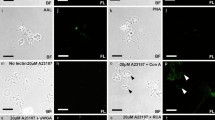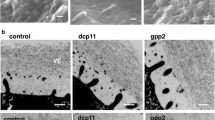Abstract
The present study aims to identify the distribution of α-D-mannose residues on zona pellucida (ZP) and their role(s) in fertilization in pigs. In experiment 1, in vitro matured pig oocytes were freed from cumulus cells and treated with fluorescein isothiocyanate-labelled Lens culinaris (FITC-LCA), a D-mannose specific binding lectin. After 30 min of treatment, LCA bound evenly throughout the ZP with strong fluorescence. In experiment 2, when LCA-treated oocytes were used for in vitro fertilization, the number of sperm bound to ZP was significantly decreased, and sperm penetration was almost completely blocked. In experiment 3, polysaccharide mannan was added to the in vitro fertilization medium as a competitive inhibitor. Both the number of sperm bound to ZP and the rate of fertilized oocytes were significantly reduced in the mannan-treated group compared with the control group. In experiment 4, spermatozoa were incubated with mannan in vitro. The number of acrosome-reacted spermatozoa was evidently increased in a time-dependent manner during the incubation. These results suggest that α-D-mannose residues presenting on pig ZP might be an important component of sperm receptor and might induce sperm acrosome reaction and thus facilitate the sperm penetration into the ZP.
Similar content being viewed by others
References
Yanagimachi R. Mammalian fertilization. In: Knobil B, Neil J D, eds. The Physiology of Reproduction. New York: Raven Press, 1988. 135–185
Wassarman P M. Early events in mammalian fertilization. Ann Rev Cell Biol, 1987, 3: 109–142
Tulsiani D R P, Nagdas S K, Corwall G A, et al. Evidence for the presence of high-mannose/hybrid oligosaccharide chain(s) on the mouse ZP2 and ZP3. Biol Reprod, 1992, 46: 93–100
Cornwall G A, Tulsian D R P, Orgebin-Crist M C. Inhibition of the mouse sperm surface α-D-mannosidase inhibits sperm-egg binding in vitro. Biol Reprod, 1991, 44: 913–921
Oikawa T, Nicholson G L, Yanagimachi R. Inhibition of hamster fertilization by phytoagglutinins. Exp Cell Res, 1974, 83: 239–246
Mori K, Daitoh T, Irahara M et al. Significance of D-mannose as a sperm receptor site in the zona pellucida in human fertilization. Am J Obstet Gynecol, 1989, 161: 207–221
Lambert H. Role of sperm-surface glycoproteins in gamete recognition in two mouse species. J Reprod Fertil, 1984, 70: 281–284
Shalgi R A, Matilvahu A, Nobel L. The role of carbohydrates in sperm-egg interaction in rats. Biol Reprod, 1986, 34: 446–452
Miranda P V, Gonzalez-Echeverria F, Marin-Briggiler C I, et al. Glycosidic residues involved in human sperm-zona pellucida binding in vitro. Mol Hum Reprod, 1997, 3: 399–404
Tulsiani D R P, Skudlarek M D, Orgebin-Crist M C. Novel α-D-mannosidase of rat sperm plasma membranes: Characterization and potential role in sperm-egg interactions. J Cell Biol, 1989, 109: 1257–1267
Dunbar B S, Raynor B D. Characterization of porcine zona pellucida antigens. Biol Reprod, 1980, 2: 941–945
Hedrick J L, Wardrip N J. On the macromolecular composition of the zona pellucida from porcine oocytes. Dev Biol, 1987, 121: 478–488
Yurewicz E C, Sacco A G, Subramanian M G. Structural characterization of the Mr=55,000 antigen (ZP3) of porcine oocyte zona pellucida. J Biol Chem, 1987, 262: 564–571
Sacco A G, Yurewicz E C, Subramanian M G et al. Porcine zona pellucida association of sperm receptor activity with glycoprotein component (ZP3) of the Mr=55,000 family (ZP3). Biol Reprod, 1989, 41: 523–532
Berger T, Turner K O, Meizel S, et al. Zona-pellucida induced acrosome reaction in boar sperm. Biol Reprod, 1989, 40: 5625–5630
Yurewicz E C, Pack B A, Sacco A G. Isolation, composition, and biological activity of sugar chains of porcine oocyte zona pellucida 55 K glycoprotein. Mol Reprod Dev, 1991, 30: 126–134
Nakano M, Yonezawa N, Hatanaka Y et al. Structure and function of the N-linked carbohydrate chains of pig zona pellucida glycoproteins. J Reprod Fertil Suppl, 1996, 50: 25–34
Wang W H, Niwa K, Okuda K. In vitro penetration of pig oocytes matured in culture by frozen-thawed ejaculated spermatozoa. J Reprod Fertil, 1991, 93: 491–496
Wang W H, Abeydeera L R, Fraser L R, et al. Functional analysis using chlortetracycline fluorescence and in vitro fertilization of frozen-thawed ejaculated boar spermatozoa incubated in a protein-free chemically defined medium. J Reprod Fertil, 1995, 104: 305–313
Lis H, Sharon N. Lectins as molecules and as tools. Ann Rev Biochem, 1986, 55: 35–67
Goldstein I J, Hughesm R C, Mousigny M, et al. What should be called a lectin? Nature, 1980, 226: 86
Skutelsky E, Ranen E, Shalgi R. Variations in the distribution of sugar residues in the zona pellucida as possible species-specific determinants of mammalian oocytes. J Reprod Fertil, 1994, 100: 35–41
Bar-Shira M B, Maymon R, Ben-Nun I, et al. Distribution of carbohydrates in the zona pellucida of human oocytes. J Reprod Fertil, 1994, 102: 81–86
Tanghe S, Van Soom A, Duchateau L, et al. Carbohydrates and glycoproteins involved in bovine fertilization in vitro. Mol Reprod Dev, 2004, 68: 492–499
Tulsiani D R P, Skudlarek M D, Orgebin-Crist M C. Human sperm plasma membranes possess α-D-mannosidase activity but no galactosyltransferase activity. Biol Reprod, 1990, 42: 843–858
Benoff S, Cooper G W, Hurley I, et al. Human sperm fertilizing potential in vitro is correlated with differential expression of a head-specific mannose-ligand receptor. Fertil Steril, 1993, 59: 854–862
Benoff S, Hurley I, Cooper G W, et al. Human sperm head-specific mannose-ligand receptor expression is dependent on capacitation-associated membrane cholesterol loss. Hum Reprod, 1993, 8: 2141–2154
Chen J S, Doncel G F, Alvarez C, et al. Expression of mannose binding sites on human spermatozoa and their role in sperm-zona pellucida binding. J Androl, 1995, 16: 55–63
Storey B T. Interactions between gametes leading to fertilization: the sperm’s eye view. Reprod Fertil Dev, 1995, 7: 927–942
Thaler C D, Cardullo R A. The initial molecular interaction between mouse sperm and the zona pellucida is a complex binding event. J Biol Chem, 1996, 271: 23289–23297
Bleil J D, Wassarman P M. Sperm-egg interactions in the mouse: sequence of events and induction of the acrosome reaction by a zona pellucida glycoprotein. Dev Biol, 1983, 95: 317–324
Loeser C R, Tulsiani D R P. The Role of carbohydrates in the induction of the acrosome reaction in mouse spermatozoa. Biol Reprod, 1999, 60: 94–101
Benoff S, Hurley I R, Mandel F S, et al. Induction of the human sperm acrosome reaction with mannose containing neoglycoprotein ligands. Mol Hum Reprod, 1997, 3: 827–837
Author information
Authors and Affiliations
Corresponding author
Additional information
Supported by the research foundation from the Ministry of Education of China for returned scholars from abroad
Rights and permissions
About this article
Cite this article
Song, X., Li, F., Cao, G. et al. Distribution of α-D-mannose residues on zona pellucida and their role(s) in fertilization in pigs. SCI CHINA SER C 50, 170–177 (2007). https://doi.org/10.1007/s11427-007-0029-x
Received:
Accepted:
Issue Date:
DOI: https://doi.org/10.1007/s11427-007-0029-x




